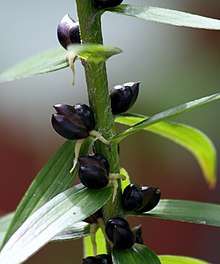Lilium lancifolium
| Lilium lancifolium | |
|---|---|
 | |
| Tiger Lily | |
| Scientific classification | |
| Kingdom: | Plantae |
| Clade: | Angiosperms |
| Clade: | Monocots |
| Order: | Liliales |
| Family: | Liliaceae |
| Genus: | Lilium |
| Species: | L. lancifolium |
| Binomial name | |
| Lilium lancifolium | |
| Synonyms[1] | |
|
Synonymy
| |
Lilium lancifolium (syn. L. tigrinum) is an Asian species of lily, native to China, Japan, Korea, and the Russian Far East. It is widely planted as an ornamental because of its showy orange-and-black flowers, and has become naturalized in numerous scattered locations in eastern North America (particularly in New England).[1][2][3][4][5][6][7][8][9][10]
It is one of several species of lily to which the common name tiger lily is applied, and some regard this the correct species to which the name should be applied. Botanists for many years considered L. tigrinum the correct scientific name until it was determined that older name L. lancifolium refers to the same species. Under the rules of international botanical nomenclature, the older name takes precedence.[2][11][12]
Growth

Like other true lilies, the flowers are borne on upright stems that are 80–200 centimetres (31–79 in) tall and bear lanceolate leaves 6–10 centimetres (2.4–3.9 in) long and 1–2 centimetres (0.39–0.79 in) broad. Lilium lancifolium produces aerial bulblets, known as bulbils, in the leaf axils. These bulbils are uncommon in Lilium species and they produce new plants that are clones of the original plant. Each flower lasts a few days and if pollinated produce capsules with many thin seeds.[2]
Cultivation and uses
.jpg)
It is cultivated in Asia for its edible bulbs. The cultivar 'Splendens' has gained the Royal Horticultural Society's Award of Garden Merit.[13]
References
- 1 2 Kew World Checklist of Selected Plant Families
- 1 2 3 Flora of North America, Vol. 26 Page 178 Tiger lily, lis tigré Lilium lancifolium Thunberg, Trans. Linn. Soc. London, Bot. 2: 333. 1794.
- ↑ Flora of China Vol. 24 Page 146 卷丹 juan dan Lilium tigrinum Ker Gawler, Bot. Mag. 31: t. 1237. 1809.
- ↑ Biota of North America Program 2014 county distribution map
- ↑ Tutin, T.G. & al. (eds.) (1980). Flora Europaea 5: 1-452. Cambridge University Press.
- ↑ Ohwi, J. (1984). Flora of Japan (in English): 1-1067. Smithsonian Institution, Washington, D.C..
- ↑ Kharkevich, S.S. (ed.) (1987). Plantae Vasculares Orientalis Extremi Sovietici 2: 1-448. Nauka, Leningrad.
- ↑ Czerepanov, S.K. (1995). Vascular Plants of Russia and Adjacent States (The Former USSR): 1-516. Cambridge University Press.
- ↑ Lee, W.T. (1996). Lineamenta Florae Koreae: 1-1688. Soul T'ukpyolsi: Ak'ademi Sojok.
- ↑ Aistova, E. (2009). Check-list of adventive flora of Amur region. Turczaninowia 12(1-2): 17-40.
- ↑ Ker Gawler, John Bellenden 1809. Lilium tigrinum, Tiger-spotted Chinese lily. Botanical Magazine 31: plate 1237 plus two subsequent text pages includes full-page color illustration, plus description in Latin and discussion in English
- ↑ Thunberg, Carl Peter 1794. Transactions of the Linnean Society of London 2: 333 in Latin
- ↑ "RHS Plant Selector - Lilium lancifolium 'Splendens'". Retrieved 26 June 2013.
External links
| Wikimedia Commons has media related to Lilium lancifolium. |